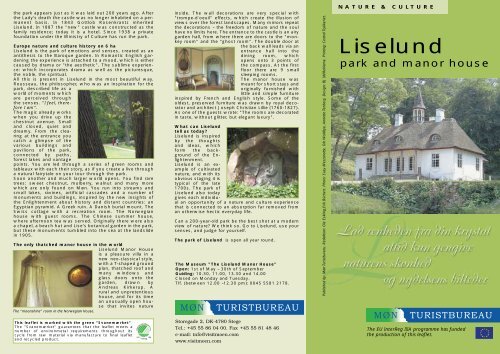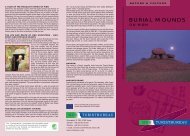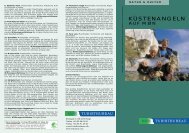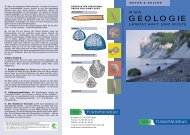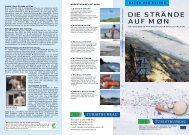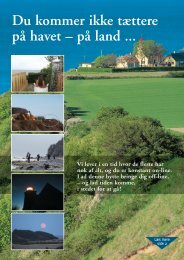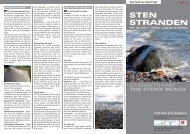Liselund - Camping Møns Klint
Liselund - Camping Møns Klint
Liselund - Camping Møns Klint
Create successful ePaper yourself
Turn your PDF publications into a flip-book with our unique Google optimized e-Paper software.
the park appears just as it was laid out 200 years ago. Afterthe Lady’s death the castle was no longer inhabited on a permanentbasis. In 1843 Gottlob Rosenkrantz inherited<strong>Liselund</strong>. In 1887 the "new" castle was constructed as thefamily residence; today it is a hotel. Since 1938 a privatefoundation under the Ministry of Culture has run the park.Europe nature and culture history on 6 ha<strong>Liselund</strong> is the park of emotions and senses, created as anantithesis to the Baroque garden. In Romantic English gardeningthe experience is attached to a mood, which is eithercaused by drama or "the aesthetic". The sublime experience:which incorporates drama as well as the picturesque,the noble, the spiritual.All this is present in <strong>Liselund</strong> in the most beautiful way.Rousseau, the philosopher, who was an inspiration for thepark, described life as aworld of moments whichare perceived throughthe senses. "I feel, thereforeI am".The magic already workswhen you drive up thechestnut avenue. Smalland closed, quiet anddreamy. From the clearingat the entrance youcatch a glimpse of thevarious buildings andpavilions of the park,connected by paths,forest lakes and vantagepoints. You are led through a series of green rooms andtableaux with each their story, as if you create a live througha natural fairytale on your tour through the park.Soon another and much larger world opens. You find raretrees: sweet chestnut, mulberry, walnut and many morewhich are only found on Møn. You run into streams andsmall lakes, ravines, artificial cascades and a number ofmonuments and buildings, inspired by the new insights ofthe Enlightenment about history and distant countries: anEgyptian pyramid. A Greek ruin. A Danish burial mount. TheSwiss cottage with a recreation room. The Norwegianhouse with guest rooms. The Chinese summer house,where afternoon tea was served. Originally there were alsoa chapel, a beach hut and Lise’s botanical garden in the park,but these monuments tumbled into the sea at the landslidein 1905.The only thatched manor house in the world<strong>Liselund</strong> Manor Houseis a pleasure villa in anew neo-classical style,with a T-shaped groundplan, thatched roof andmany windows andglass doors onto thegarden, drawn byAndreas Kirkerup. Arural and unpretentioushouse, and for its timean unusually open housethat invites natureThe “moonshine” room in the Norwegian House.inside. The wall decorations are very special with"trompe-d´oeuil" effects, which create the illusion ofviews over the forest landscapes. Many mirrors repeatthe decorations – the freedom of nature and the soulhave no limits here. The entrance to the castle is an airygarden hall, from where there are doors to the "monkeyroom" and the "ghost room". The double door atthe back wall leads via anentrance hall into thedining room, whichopens onto 3 points ofthe compass. At the firstfloor there are 9 smallsleeping rooms.The manor house wasmeant for short stays andoriginally furnished withlittle and simple furnitureinspired by French and English style. Some of theoldest, preserved furniture was drawn by royal decoratorand architect Joseph Christian Lillie (1760-1827).As one of the guests wrote: "The rooms are decoratedin taste, without glitter, but elegant luxury".What can <strong>Liselund</strong>tell us today?<strong>Liselund</strong> is inspiredby the thoughtsand ideas, whichform the backgroundof the Enlightenment.<strong>Liselund</strong> is an exampleof cultivatednature, and with itsobvious staging it istypical of the late1700s. The park of<strong>Liselund</strong> also todaygives each individualan opportunity of a nature and culture experiencethat is connected to an absorption far removed froman otherwise hectic everyday life.Can a 200-year-old park be the best shot at a modernview of nature? We think so. Go to <strong>Liselund</strong>, use yoursenses, and judge for yourself.The park of <strong>Liselund</strong> is open all year round.The Museum "The <strong>Liselund</strong> Manor House"Open: 1st of May – 30th of SeptemberGuiding: 10.30, 11.00, 13.30 and 14.00Closed on Monday and Tuesday.Tlf. (between 12.00 –12.30 pm): 0045 5581 2178.Published by: Møn Turistbureau. Redaktion: Ole Eskling,Erik Büchert. Photo: Susy Mezzanotte, Ole Woldbye, Annette Tenberg. Design: BJ IdéReklame. Printing: Central Trykkeriet.NATURE & CULTURE<strong>Liselund</strong>park and manor houseThis leaflet is marked with the green "Svanemærket"The "Svanemærket" guarantees that the leaflet meets anumber of environmetal requirements throughout itscycle from raw material via manufacture to final leafletand recycled product.541 186TryksagStoregade 2, DK-4780 StegeTel.: +45 55 86 04 00. Fax +45 55 81 48 46e-mail: info@visitmoen.comwww.visitmoen.comThe EU InterReg IIIA programme has fundedthe production of this leaflet.
LISELUND PARK AND MANOR HOUSE1.PLANAccess through the avenue ofchestnuts2. Parking lot and toilet building3. The Swiss cottage with the gardener’slodge. Old walnut treesin front of the house and the icecream stall at the hill behind it4. The lily pond, the mirror of thecastle5. The castle, regular guided toursduring the summer season6. "The kitchen park"7. The writer’s lake with hazelcoveredinlets and the pyramidlake with the Pan monument8. Small stream supplying thelakes with streaming water,ending in the sea under the cliff9. The hill in the wood, which wasplanted in the 1770s10. The large lake with its island atthe bottom of the beam-shapedclearing11. The stone of Graces with theinscription: "Elles attendent icileur soeur"12. The deep ravine with the devil’sbridge13. The cliff cross14. Path leading from the clearingto the beach15. The Norwegian cottage, the logcabin at the highest spot of thepark. To the east of this yet anotherhidden privy16. The monumental group ofsweet chestnut trees17. The Chinese summer house18. "The new castle", built in 1887,today a hotel118P17Let your pure crystal watersAlways reflect onlyThe grace of natureAnd the image of pleasure2 31610Antoine de la Calmette154695711Louis Gurlitt. 1842. Statens Museum for kunst.1281413Morning gift to Lise<strong>Liselund</strong> Park was established at the end of the 1700s andis one of the finest Danish and Scandinavian examples ofRomantic "English" gardening. A poetic spot, which epitomizesthe whole worldin the spirit of the times.In 1783 the present <strong>Liselund</strong>was bought by theowner of Marienborg onwestern Møn, prefectLord Antoine de la Calmette(1752-1803). Hewas educated as a cornetin the Royal Guard andwas in 1777 appointedcaptain.In 1777 he was married to Anna Cathrine Elisabeth Iselin,called Lise (1759-1805). Everything points to a very happymarriage, and throughout their marriage Antoine showedher "the chivalrous, romantic worship of an indefatigablelover". A foreign diplomat characterized her in the followingway:"A woman who presents herself to perfectionand whom you should indisputably count among beautifulladies".The couple was at home in literature and art, and on theirformative travels in Europe they became enthusiasticabout Rousseau’s philosophy of nature, which they foundin Romantic gardens, theyvisited. It was where partsof the inspiration of <strong>Liselund</strong>came from. The parkwas laid out in the yearsabout 1790 with Antoinehimself as prime mover.The park as well as thebuildings are constructedto the last detail with lovefor the place and the personwho gave the park itsname: <strong>Liselund</strong> is a lovegift to Lise.Portrait of Antoine and Lise de la Calmette– painted in 1782 of Jens Juel (1745-1802)The Golden bride of <strong>Liselund</strong>Unfortunately both Antoine and Lise died young. Their onlyson, Lord Charles de la Calmette (1781-1820) was marriedto Martha Mackeprang (1788-1877) in 1810. Lord de laCalmette was not lucky in finances, and as the couple waschildless, <strong>Liselund</strong> was sold to Frederic Huitfeldt Levetzauat the death of the Lord. Lady de la Calmette stayed at<strong>Liselund</strong> castle as a widow for 57 years. It is said that untilher dying day she was firmly convinced that she was stillthe owner of the place – and that the new owner let herstay in her belief. Martha had numerous friends. Some ofthe greatest artists of the Golden Age, like Oehlenschläger,Andersen and Thorwaldsen, were among the guests at<strong>Liselund</strong>. The poet Vilhelm Birkedal paid tribute to her by this:She is sitting so quiet.A golden bride in spite of widow hair,Her youth loves´ memoryShe has guarded in half hundred years.With her love for the place it was as if she had "breathedthe soul of nature into her soul"; she was "the clearestimage of the grove" (‘lund ‘ means grove). White was herfavourite colour, everything around had to be white: doves,ducks, hens, turkeys, even the peacocks and the white roethat followed her like a dog. No visual memories of heryouth were touched or moved. We owe it to Martha that


